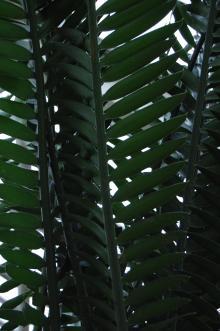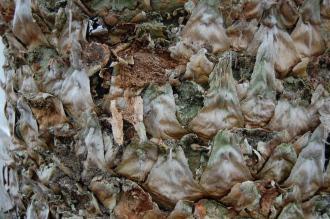
Encephalartos longifolius (09/02/2013, Kew Gardens, London)
Position: Full sun to light shade
Flowering period: Late spring to early summer
Soil: Moist, well drained
Eventual Height: 4m
Eventual Spread: 4m
Hardiness: 9b – 11
Family: Zamiaceae
Encephalartos longifolius is a low-growing, evergreen palm like tree. Its metallic green leaves are up to 2m long, arching, with up to 120 leaflets. Its leaflets are lanceolate with entire margins, overlapping, up to 20cm long and 3cm broad. Its trunk may achieve a diameter of up to 30cm. Its flowers are dioecious. Its male strobili (cone like structures) are bright orange, cylindrical, up to 60m long and 20cm across. Its female ‘cones’ are up to 60cm long and 40cm across. Its seeds are red and up to 5cm long and 3cm broad. Suckers are produced which can be removed and propagated.

Encephalartos longifolius Leaf (09/02/2013, Kew Gardens, London)
Encephalartos longifolius, commonly known as Breadpalm, Suurberg Cycad, Long-Leafed Cycad or Broodbroom, is native to Eastern Cape Province, South Africa. In its native habitat it grow in scrubland on steep rocky slopes. This plant is classified as Near Threatened according to the IUCN Red List of Threatened Species.
The etymological root of the binomial name Encephalartos is derived from the Greek en meaning ‘in, kefalos meaning ‘head’ and artos meaning ‘cake’. Longifolius is derived from the Latin longus meaning long and folius meaning ‘leaf’.
The landscape architect may find Encephalartos longifolius useful as an attractive, small accent tree. Once established this tree is drought tolerant.
Ecologically, Encephalartos longifolius is attractive to pollinating insects.

Encephalartos longifolius Bark (09/02/2013, Kew Gardens, London)
Encephalartos longifolius prefers moist, fertile, well-drained soils. It prefers an acid to neutral pH of soil. It will not tolerate wet soils.
Encephalartos longifolius requires little maintenance.

